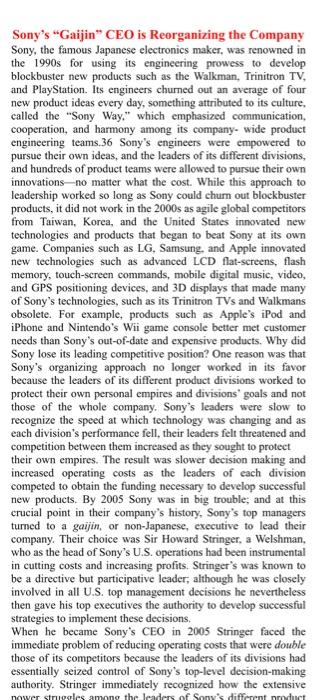1. What pressures and forces from the environment led Stringer to change the balance between centralizing and decentralizing authority at Sony? 2.how would you describe
1. What pressures and forces from the environment led Stringer to change the balance between centralizing and decentralizing authority at Sony?
2.how would you describe Stringer’s approach to organizing? Is he seeking to create a more mechanistic
or organic structure, or what kind of balance between them?


Sony's "Gaijin" CEO is Reorganizing the Company Sony, the famous Japanese electronics maker, was renowned in the 1990s for using its engincering prowess to develop blockbuster new products such as the Walkman, Trinitron TV, and PlayStation. Its engineers churmed out an average of four new product ideas every day, something attributed to its culture, called the "Sony Way," which emphasized communication, cooperation, and harmony among its company- wide product engineering teams.36 Sony's engineers were empowered to pursue their own ideas, and the leaders of its different divisions, and hundreds of product teams were allowed to pursue their own innovations-no matter what the cost. While this approach to leadership worked so long as Sony could churn out blockbuster products, it did not work in the 2000s as agile global competitors from Taiwan, Korea, and the United States innovated new technologies and products that began to beat Sony at its own game. Companies such as LG, Samsung, and Apple innovated new technologies such as advanced LCD flat-screens, flash memory, touch-screen commands, mobile digital music, video, and GPS positioning devices, and 3D displays that made many of Sony's technologies, such as its Trinitron TVs and Walkmans obsolete. For example, products such as Apple's iPod and iPhone and Nintendo's Wii game console better met customer needs than Sony's out-of-date and expensive products. Why did Sony lose its leading competitive position? One reason was that Sony's organizing approach no longer worked in its favor because the leaders of its different product divisions worked to protect their own personal empires and divisions' goals and not those of the whole company. Sony's leaders were slow to recognize the speed at which technology was changing and as each division's performance fell, their leaders felt threatened and competition between them increased as they sought to protect their own empires. The result was slower decision making and increased operating costs as the leaders of each division competed to obtain the funding necessary to develop successful new products. By 2005 Sony was in big trouble; and at this crucial point in their company's history, Sony's top managers turned to a gaijin, or non-Japanese, executive to lead their company. Their choice was Sir Howard Stringer, a Welshman, who as the head of Sony's U.S. operations had been instrumental in cutting costs and increasing profits. Stringer's was known to be a directive but participative leader, although he was closely involved in all U.S. top management decisions he nevertheless then gave his top executives the authority to develop successful strategies to implement these decisions. When he became Sony's CEO in 2005 Stringer faced the immediate problem of reducing operating costs that were double those of its competitors because the leaders of its divisions had essentially seized control of Sony's top-level decision-making authority. Stringer immediately recognized how the extensive nower struggles amono the leaders of Sony's different product
Step by Step Solution
3.47 Rating (163 Votes )
There are 3 Steps involved in it
Step: 1

See step-by-step solutions with expert insights and AI powered tools for academic success
Step: 2

Step: 3

Ace Your Homework with AI
Get the answers you need in no time with our AI-driven, step-by-step assistance
Get Started


